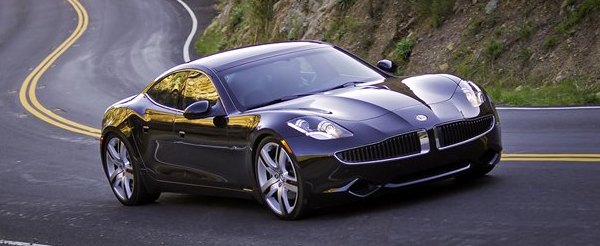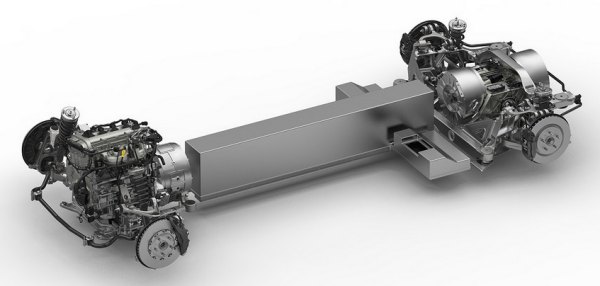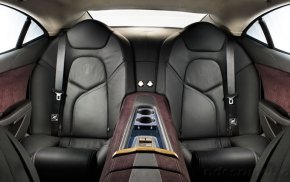| Published
on 21
Apr
2012 |
All rights reserved.
|
|
|

A sky-blue Nissan Leaf
parks downstairs just outside my office. It looks cool, not only in
terms of design but also the green philosophy it brings. Electric cars
achieve zero emission on the road and substantially lower well-to-wheel
emission than conventional internal combustion cars. It is the greenest
automobile technology available today – forget the unrealistic hydrogen
or solar-powered cars – but when it comes to cost, range and
convenience it is just not good enough to rock the domination of
conventional motors. Even being subsidized by government incentives,
EVs are still far too expensive to purchase. What if our cash-strapped
governments stop subsidizing? That could be a nightmare to
Nissan-Renault.
If EVs have yet to come to prime time, what about hybrids? Toyota makes
a lot of money with Prius. Hybrid technology is relatively matured,
practical and affordable, but on the flip side its carbon footprint is
not small enough – sometimes diesel engines can achieve lower emission
in the real world. To bridge the gap between hybrids and pure EVs,
clever engineers invented plug-in
hybrids. Its concept is simple: by adopting a larger battery and
allow it to be recharged through our home sockets, the car can offer
dozen miles of zero-emission ride, suitable for commute between home
and workplace. In case it runs out of battery during longer journey, an
on-board gas (or diesel) engine fires up and acts as generator,
supplying the electric motor and recharging the battery. This allows
the car to be refilled at gas stations and extend its range like
conventional cars. Therefore the engine is also called "range
extender".
The first production plug-in hybrid is BYD F3DM, born in 2008. It has
the engine and electric motor arranged to work in parallel so that each
can propel the car independently. In contrast, a series plug-in hybrid has the engine
arranged to supply the electric system rather than to drive the wheels.
This mean propulsion is always provided by the electric motor. Not only
mechanically simpler, it is also considered to be more energy efficient
as the engine is no longer relevant to vehicle speed thus it can be
configured to spin at its most efficient rev. Chevrolet Volt is the
first production example of such systems.
Fisker Karma
is also a series plug-in hybrid. When it made world debut in the 2008
Detroit motor show, it arouse quite a sensation with its stylish
looks, innovative concept as well as state-of-the-art technology. At
that time, Chevrolet Volt was no more than a sketchy concept, but the
Karma was already close to final production form – production was
scheduled in late 2009. It could have beaten Volt to the market if
Fisker had the resources and established expertise of General Motors.
As it did not have, the production delayed until late 2011.
The Karma is absolutely a beauty. It is a Panamera-size 4-door 4-seater
yet it possesses a shape rivaling the best Italian sports cars. This is
hardly a surprise because Henrik Fisker, the company owner and its
designer, is renowned for styling Aston Martin DB9, V8 Vantage and BMW
Z8 before founding his coachbuild business and eventually Fisker
Automotive. Its coke-bottle shape and huge, 22-inch wheels help hiding
its
bulk very well, leading to an impression of a much smaller car. In
fact, this car measures a full 5 meters from nose to tail and 2 meters
across its shoulders. It tips the scale at a Bentley-rivaling 2400 kg!
Can you believe?

The massive
weight is not without reasons. The aluminum spaceframe chassis is not
only large but also engineered to be very stiff, with a torsional
rigidity of 35,000 Nm per degree. The transmission tunnel carries 20kWh
of lithium-ion batteries that weigh some 300 kilograms. As you can see
from the picture above, there are two large electric motors located
fore and aft of the rear differential respectively. Each of them is
capable to deliver 201 horsepower and 480 pound-foot of torque to the
rear wheels. Up front, there is a GM-sourced 2-liter four-cylinder
direct-injection turbo engine mounted longitudinally. It used to serve
under the bonnet of Pontiac Solstice GXP, and is now the only trace
left for that car. Still produces 260 horsepower, but now all those
horses are used to spin a powerful generator located just behind the
engine. On the roof, there are solar cells to deliver a green message.
All these components contribute to its immense weight. Have I
mention the 36-liter fuel tank?
Consequently, the Karma is not as fast as it looks. Despite of a total
of 403 horsepower and a staggering 959 pound-foot of torque –
the latter rivals Bugatti actually – it takes 6.1 seconds to accelerate
from zero to sixty, and that is achieved with Sport mode engaged, in
which both battery and generator supply the electric motors. In
"Stealth" mode, where only battery power is available, the same
acceleration takes a
leisurely 8 seconds, whereas top speed is limited to 95 mph. Sport mode
is slightly better, raising the electronic limiter to 125 mph.
Theoretically, the combination of 400 horsepower and
0.31 drag coefficient should enable a terminal velocity of over 170
mph, but at that speed battery level would be draining at alarming
rate. No wonder Karma refuses to be an Autobahn rocket. In normal
driving, it has enough instant torque to pass slower traffic, but at no
point it feels brisk enough to chase a hot hatch, say, Renault Clio RS
or Golf GTI, let alone the premium performance saloons that cost
comparable money.

Comparatively, its handling is better than expected. As the heavy
battery pack is mounted low in the chassis and close to the roll
center, the Fisker corners flatly at fast bends. Its 47:53 weight
distribution leads to a fairly neutral attitude, although it
understeers gently when it approaches the limit of adhesion. Its
old-school electrohydraulic steering – an odd companion with a green
car it might be – could shame many modern sports cars for feel.
However, the Karma is not to be confused with a sports saloon. Its
low-speed handling is handicapped by its sheer size and weight. It runs
out of grip early, as Car and Driver found it managed only 0.87g on
skid-pad, blame to the weight again. Despite of large Brembo brakes,
its regenerative braking is non-linear and hard to modulate. Ditto the
on-off switch-like throttle, which makes it difficult to drive smoothly
in the twisty or in traffic. It seems like the tremendous electric
torque and immense weight are fighting with each other rather than
working in harmony.
Ride quality from the fixed-rate dampers and low-profile tires is
unexpectedly comfortable on motorway, although low-speed ride on bumpy
surfaces is not so good. The cabin remains silent when the car cruises
in Stealth mode, but once the old Ecotec engine fires up you will hear
a coarse soundtrack – no wonder Fisker decided to switch to BMW N20
engine for its next car.
The BMW engine will also bring better fuel economy. The Ecotec might
mean eco-technology, but that was the technology of six years ago. EPA
said the car returns only 20 mpg when the Ecotec engine is spinning,
hardly to be called green. You had better to use plug-in charging as
much as possible, but EPA found its electric range is only 32 miles (51
km), far shorter than the claimed 50 miles. Conclusion: its green
credential is limited.

The cabin is a mixed bag. For the first attempt of a low-volume
manufacturer, its build quality isn't bad. It also packs plenty of
high-tech gadgets, such as color LCD instrument dials and a 10.2-inch
touch screen through which you can control the audio, air-con, sat-nav
and phone etc. On the downside, the interior design is less attractive
than the exterior, while the varying materials show the lack of either
taste or consistency. The steering wheel and the leather seats have a
smell of mass production compare with those we found in its German or
Italian rivals. Fortunately, the driver seat is comfortable, whereas
visibility is surprisingly good, especially forward.
The Karma is a nightmare of packaging – the car is so big yet the
glasshouse is so small. Furthermore, the battery-containing central
tunnel robs the cabin a large chunk of space. Rear seats are nearly as
cramped as Aston Martin Rapide's, and the boot is even smaller at 195
liters. Figure in its US$103,000 / £73,000 / €86,000 base price,
the Fisker is the least convincing rival to Maserati Quattroporte,
Porsche Panamera and Jaguar XJ Supersport.
 
Even if customers can accept its shortcomings in performance, interior
and accommodation, they may worry about its unproven reliability. The
Karma is assembled by Valmet in Finland, which has wealth of experience
building Porsche Boxster/Cayman thus should not be the source of
problem. Its problems lie on the development process. A small firm like
Fisker lacks the necessary resources and experience to test the car
thoroughly and iron out all the problems before reaching customers. As
a result, the car shows many electronic and software glitches. The
battery, supplied by American company A123, is another source of
problems. The first 240 cars were recalled as they found the battery's
liquid cooling circuit was misaligned, which could cause leakage and
even electric short-circuit. Later on, a Karma embarrassingly died in
the test of Consumer Reports, again due to a faulty battery. Each
publicized incident becomes a hurdle to sell the car. At the time of
writing, Fisker has built about 1300 Karmas, but to meet the original
target of 15,000 cars a year will be very difficult. As much admiration
we have on the concept, we could not recommend to put your hard-earn
money on the car.
|
Verdict:   |
|